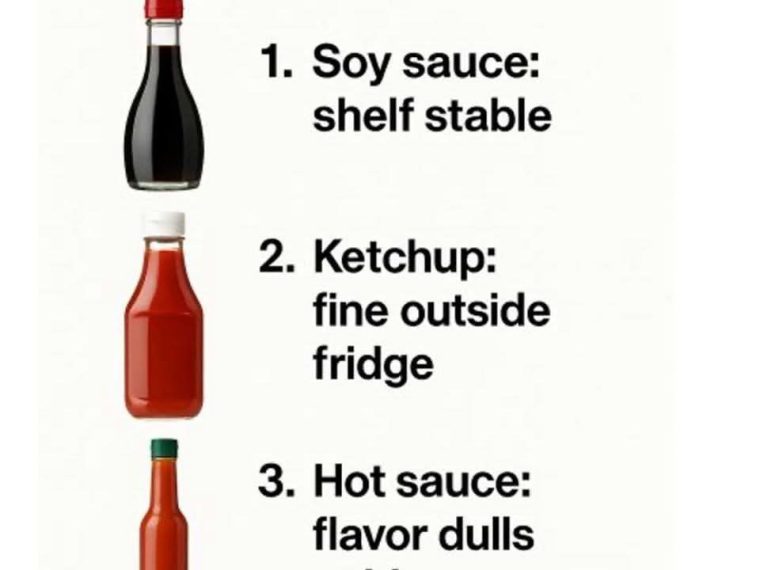In the quest for food safety and longevity, many of us routinely refrigerate a wide array of condiments. However, not all items in your pantry benefit from the chilly confines of a refrigerator. In fact, certain condiments not only maintain their quality at room temperature but may also lose flavor or texture when refrigerated.
Understanding which condiments truly need refrigeration, and which do not, can help you optimize your fridge space and keep your condiments tasting their best. Below, we explore ten condiments that you can confidently store in your pantry or cupboard, ensuring they remain flavorful and fresh without the need for refrigeration.
1. Soy Sauce: Shelf Stable Superstar
Soy sauce, which is high in sodium, is naturally resistant to bacterial growth. The fermentation process used to make soy sauce also contributes to its long-lasting nature. When stored in a cool, dark place, soy sauce can maintain its quality for up to two years. Refrigeration is unnecessary and can even dull its complex flavors over time, making a pantry the perfect home for this umami-packed condiment.
2. Ketchup: Pantry-Friendly Favorite
Ketchup is often stored in the refrigerator, but it can be safely kept in the pantry after opening. This is due to its high acidity, which acts as a natural preservative. While refrigeration can extend its shelf life, ketchup can last for about a month in the pantry without spoiling. However, if you consume ketchup slowly, refrigerating it might be beneficial to maintain taste and color over a longer period.
3. Hot Sauce: Avoid Flavor Dulling
The vinegar and salt content in most hot sauces make them naturally shelf-stable. Storing hot sauce in the refrigerator can actually mute its fiery flavors. At room temperature, hot sauce retains its vibrant taste and consistency for up to six months. Variants with fruit or garlic may require refrigeration, but the majority are perfectly happy in your pantry.
4. Mustard: Pantry Perfection
Mustard, similar to ketchup, contains vinegar which acts as a preservative. This allows mustard to be stored in a pantry for up to two months. Refrigeration can extend its shelf life, but it isn’t necessary for safety. If you prefer your mustard at room temperature for easier spreading, keeping it in the pantry is a great option.
5. Honey: Natural Preservation Champion
Honey is one of the few foods that can last indefinitely without refrigeration. Its low water content and acidic pH inhibit bacterial growth, making it naturally stable. Refrigerating honey can cause crystallization, making it harder to use. Keep honey in a tightly sealed container at room temperature to enjoy its smooth, sweet texture.
6. Peanut Butter: No Chill Needed
Natural peanut butter can separate over time, but refrigeration isn’t required to prevent spoilage. The oils in peanut butter can become hard and difficult to spread when refrigerated. For smooth and spreadable peanut butter, store it in a cool, dry place and use it within three months of opening.
7. Olive Oil: Cooler Not Required
Olive oil should be kept in a cool, dark place, but not in the refrigerator. The cold can cause it to become cloudy and solidify, disrupting its smooth texture. Stored in a pantry, olive oil stays fresh for up to six months after opening. Use a dark glass bottle to protect it from light, which can degrade its quality.
8. Vinegar: Naturally Long-Lasting
Vinegar is highly acidic, making it a naturally long-lasting condiment that doesn’t require refrigeration. It can be stored at room temperature indefinitely. Flavored vinegars may lose their potency over time, but this is a matter of taste rather than safety. Keep vinegar in a cool, dark place to maintain its robust flavor.
9. Maple Syrup: Room Temperature Sweetness
Pure maple syrup can be stored in the pantry before opening. Once opened, it’s recommended to refrigerate to prevent mold. However, if consumed quickly, especially within a month, it can remain at room temperature. For longer storage, consider freezing it, as this does not affect its flavor.
10. Jam: Sugar-Preserved Pantry Staple
Jam and preserves, which are high in sugar, don’t need to be refrigerated immediately. Sugar acts as a preservative, allowing jam to be stored in a pantry for about a month after opening. If you consume it slowly, refrigeration is advisable to maintain its freshness for a longer period.
11. Worcestershire Sauce: Room Temperature Ready
Worcestershire sauce contains vinegar and molasses, both of which contribute to its long shelf life. It can be stored at room temperature for up to a year after opening. Refrigeration is not required and can alter its taste. Keep it tightly sealed in a cool, dark place for optimal flavor preservation.





